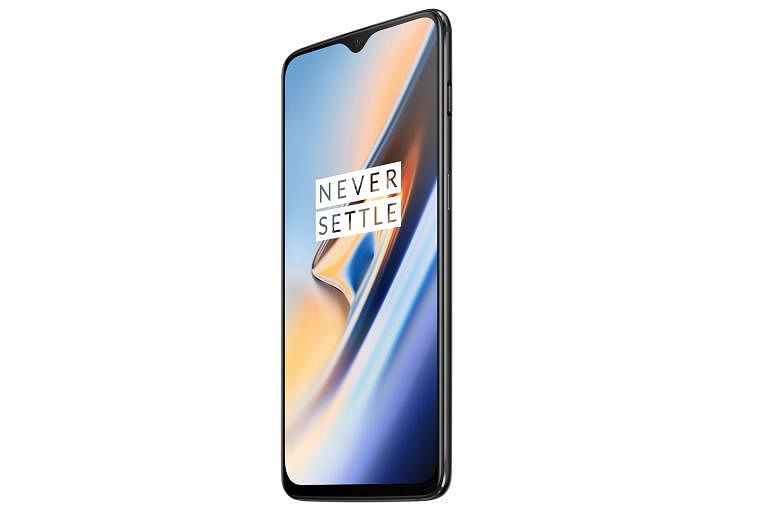The OnePlus 6T is the second major launch of the year from the Chinese brand, known for making smartphones with similar performance as flagship models from established names, but at a lower price.
It follows on the heels of the OnePlus 6, released here in July. Both models boast top-tier performance backed by the flagship Qualcomm Snapdragon 845 processor.
But the 6T changes things up in terms of design and features and not always for the better.
Notably, it loses the 3.5mm headphone jack, like many recent smartphones. A USB-C adapter is bundled for wired headphones. Or you could use wireless headphones instead.
However, those who dislike the screen notch design of the OnePlus 6, may find the 6T's smaller teardrop-shaped notch more tolerable.
This notch accommodates a single 16-megapixel front camera that offers the usual features - a face retouching beauty mode and a portrait mode that uses software to create a blurred background effect, or bokeh.
The front camera is also used for the 6T's face unlock feature, which is really fast. But it does not work in the dark as there is no infrared camera.
-
TECH SPECS
PRICE: $988
PROCESSOR: Qualcomm Snapdragon 845 (Quad-core 2.8GHz, quad-core 1.7GHz)
DISPLAY: 6.41-inch, Amoled, 2,340 x 1,080 pixels, 402 ppi pixel density
OPERATING SYSTEM: OxygenOS (Android 9.0)
MEMORY: 128GB, 8GB RAM
REAR CAMERA: 16MP (f/1.7) and 20MP (f/1.7)
FRONT CAMERA: 16MP (f/2.0)
BATTERY: Non-removable 3,700mAh
-
RATING
FEATURES: 4/5
DESIGN: 4/5
PERFORMANCE: 5/5
VALUE FOR MONEY: 4/5
BATTERY LIFE: 4/5
OVERALL: 4/5
The other major change is the switch to an in-display fingerprint sensor from the rear version. This in-display sensor is similar to the one I tested on the Vivo Nex S. A small glowing circle on the 6T's Oled screen indicates where you should place your finger.
It feels fast and is accurate enough, though perhaps a fraction slower than the usual rear fingerprint sensor. Also, the illuminated indicator becomes very bright and near-blinding in the dark when you put your finger to it.
The 6.4-inch Oled screen looks very good, especially with narrow bezels all round and a relatively small chin. It looks sharp and vibrant.
OnePlus offers a number of screen calibration settings, from sRGB to DCI-P3 colour profiles. You can also tweak the colour temperature for a warmer or cooler look.
Like the previous model, the 6T lacks some flagship phone perks, like wireless charging. It does not have an official water-resistance rating, though OnePlus says it is water-resistant.
Its dual cameras are identical to its predecessor. Photos shot with its HDR feature look bright and vibrant, but they do not stand out from other flagship smartphone cameras.
The 6T does have a new trick - a Nightscape mode for low-light photography. To use this long-exposure mode, you have to hold the camera steady for a few seconds after pressing the shutter button to allow the camera to capture more light.
Comparing photos shot with Nightscape with images taken without, Nightscape seems to reduce blown highlights from light sources such as lamps. But while Nightscape increases the brightness slightly and captures more details, it is not that much of an improvement.
The 6T is one of the few smartphones, besides Google's Pixel and Huawei's Mate 20 smartphones, to ship out of the box with the latest Android 9 mobile operating system, though layered with OnePlus' OxygenOS skin on top.
For the most part, the OxygenOS interface is clean and feels very much like stock Android. Some of OnePlus' tweaks are handy too.
For instance, you can swipe down the middle of the Home screen to bring up the notification shade without having to stretch your fingers to the top of the screen to do so.
OxygenOS also has its own set of full-screen navigation gestures that does away with the bottom Android navigation bar. These gestures are very usable and slightly increase the screen real estate, unlike Android 9's gestures.
It runs fast and smooth, thanks to the 8GB of system memory on my review set (the base 6T model comes with 6GB). However, I was surprised that the 6T scored slightly lower in the GeekBench 4 system benchmark (8,782) compared with the OnePlus 6 (9,092). This is despite the OnePlus 6 having only 6GB of RAM.
It comes with a 3,700mAh battery, up from the 3,300mAh version on the OnePlus 6. For me, it comfortably lasts over a day. In our video-loop battery test, it clocked 12 hours and 38 minutes.
Compared with its predecessor, the price of the base OnePlus 6T (6GB RAM, 128GB storage) has inched upwards by $30 to $898. The internal storage, though, has been increased from 64GB to 128GB, which is not to be sniffed at, seeing as the OnePlus 6 and 6T do not have expandable storage.
• Verdict: With top phones from earlier this year, such as the Huawei P20 Pro and the Samsung Galaxy S9, becoming cheaper, the OnePlus 6T's value proposition is not as attractive, especially when it falls slightly short of a true flagship device.


